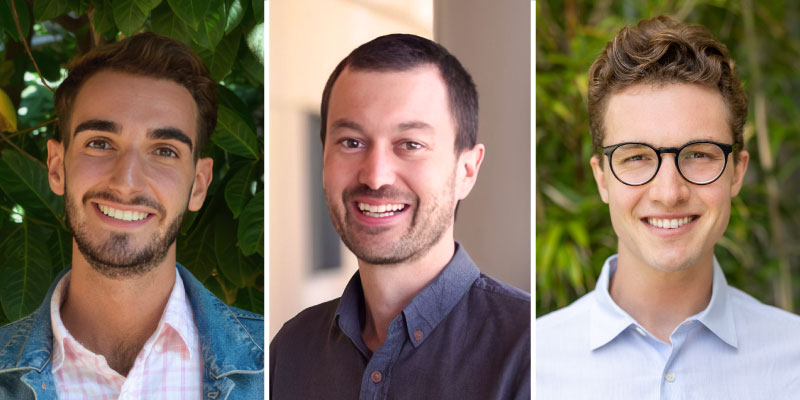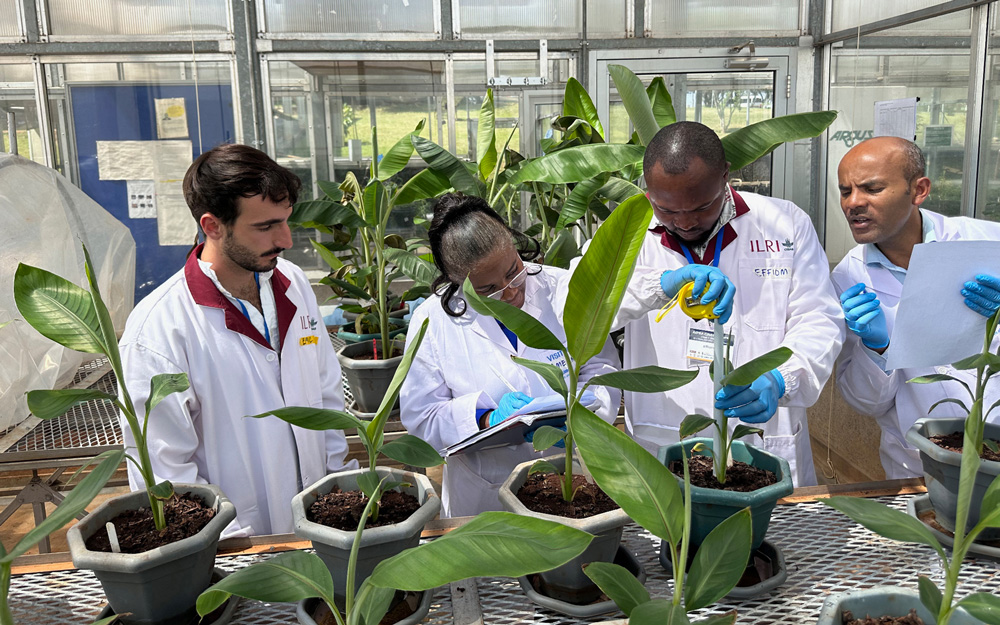Berkeley, California, USA
February 2, 2024
2023 was the inaugural year for the AfPBA CRISPR Course In Gene Editing for African Plant Scientists. IGI Investigator Dave Savage and IGI graduate students Evan Groover and Nicholas Karavolias went to Nairobi, Kenya to teach the innovative new course aimed at empowering scientists from across Africa to use CRISPR.
The CRISPR Course is a year-long program offered by the IGI in partnership with the African Orphan Crops Consortium, the Seed Biotechnology Center at UC Davis, and the International Institute of Tropical Agriculture, as part of the African Plant Breeding Academy. Learn more about the course here.
In late 2023, IGI’s Content Strategist Hope Henderson spoke to Savage and Groover about the course’s first year.
In May, we spoke about your trip to Kenya as part of the AfPBA CRISPR course. Tell me about your most recent visit.
Savage: We had three sessions: January, May, and then this October. The October session was the culmination of the whole course, where all the students had to present research proposals about how they like to use CRISPR to serve their local communities moving forward. In addition to wet lab experiments, working with them to develop the proposals was a big part of the course. It ended with a big graduation ceremony too.
 IGI Investigator Dave Savage (center) and IGI graduate students Nicholas Karavolias (left) and Evan Groover (right)
IGI Investigator Dave Savage (center) and IGI graduate students Nicholas Karavolias (left) and Evan Groover (right)
What sorts of crop applications were the African scientists interested in using CRISPR for?
Groover: Our participants are planning to use CRISPR in a wide variety of crop species, all of which have regional significance in their home countries. And their phenotypic targets are diverse — everything from delaying crop development to extend the growing season, to removing toxic compounds from crops that feed livestock. It’s a powerful demonstration of all of the ways we might use gene editing to have social and agricultural impact.
The main goals of this course is to empower these scientists to address the needs of their local community. Were you surprised by the crops and traits that they are targeting?
Savage: In Africa, farmers grow a lot of conventional row crops like corn and maize. So some of those targets are more known. In those plants, it was more about going after particular traits that might be relevant in a local variety that grows well under their particular climate conditions. Some were also less expected. For example, one scientist from Ethiopia is trying to make a hulless barley that doesn’t have to be pounded in order to release the grain because there’s a lot of manual labor involved in this particular processing. So, that’s a consumer-focused trait which is very particular to Ethiopia.
The students also had a lab project they were working on through the year. Tell me about that.
Groover: They learned the principles of Cas9 gene editing all the way from theory to practice. And- quite uniquely I might add- they worked entirely in banana. They performed molecular cloning, tissue culture, and regeneration to produce edited plants, and phenotyped the resultant varieties some months later. In doing so, they acquired the general expertise to run gene editing projects at their home institutions and in their species of interest.

What do you see coming next for the students?
Savage: The intent of the course is really that it’s not just an educational course, it’s a professional development course. We want them to take their research proposal projects and develop them further. In fact, each participant was given a modest grant to catalyze building up these resources at their home institutions and to execute on this particular product that they’re trying to bring to market. So the intent by all means is that these plant lines will be created and then they will work with plant breeders to ultimately make a product that can reach the market.
Will you be following up with them to see how they’re progressing?
Groover: We’re developing a framework by which we’ll be in contact with our students, and they’ll have some access to us over this next year. But really the hope is that they’re ready to hit the ground running. Each participant has trainees waiting in the wings to act on these projects, and we hope that this course curriculum can reach many scientists beyond those that we’ve immediately trained.
Savage: All of the participants were mid-career and helping to run research groups at their home institution. Some people had 20 people underneath them and one was in a role similar to a chair of a department. So, they’re well-positioned to bring these tools to their own folks and, ideally, the tools will be disseminated across the local institutions.
The model there is from the African Plant Breeding Academy, which is now in its 10th year. They have trained almost 200 plant breeders pan-Africa. I think the vision from Howard Shapiro at UC Davis was always that you’ve got the Orphan Crops Consortium, which is helping African scientists understand their plants, the plants that people eat. They’re sequencing the genomes in a highly collaborative way. Then there is the African Plant Breeding Academy. Every African country and almost every major plant research institution has plant breeders educated by the Plant Breeding Academy to use genomic resources for improved breeding. Then there is the more molecular view here with CRISPR, which ties everything together in a way. You start to merge those to where the molecular biologists can do CRISPR editing for traits that you couldn’t normally access through conventional approaches.

Tell me about the new cohort starting in January 2024.
Savage: The second session, CRISPR II, starts in January. And that’ll run a similar timeline through the next cycle, with a similar number of students. Nicholas, Evan, and I will continue to teach the course. If we get the funding, we hope to expand the class size in the future, as well as the mentorship support.
Karavolias: Our next cohort includes 11 students. Many of the students come from the same nations that students from our first cohort came from. We are excited to be building towards greater national capacities and are hopeful that these scientists in proximity can support one another to scale their gene editing capacities. I think this works towards the long-term vision of the course imagining African scientists as fully-autonomous gene editors.
Gender equity of our course participants remains on our mind. Six of the eleven members of our new cohort are women, and this type of representation is what we will continue to aspire to.
How has this influenced your thinking on CRISPR?
Groover: My key takeaway is that a lot of what prevents this technology from getting into the hands of the many is infrastructural and regulatory hurdles. As we envision the future of the technology there are so many exciting projects that you could imagine- like people working on orphan crops, or on relatively under-improved local varieties. But I think in the short term, maybe the most important things that need to be addressed are questions of access: to resources, editors, and information.
Learn more about the course here.